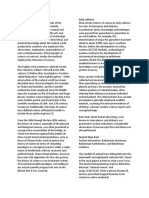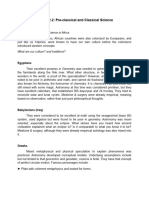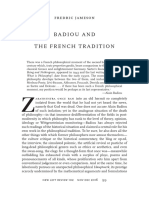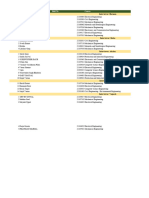Athens To Baghdad
Athens To Baghdad
Uploaded by
Umer MasoodCopyright:
Available Formats
Athens To Baghdad
Athens To Baghdad
Uploaded by
Umer MasoodOriginal Description:
Original Title
Copyright
Available Formats
Share this document
Did you find this document useful?
Is this content inappropriate?
Copyright:
Available Formats
Athens To Baghdad
Athens To Baghdad
Uploaded by
Umer MasoodCopyright:
Available Formats
previous index next
How Classical Knowledge Reached Baghdad
Michael Fowler (This is a Draft Version, 10/2/07)
The Classical Achievement in Mathematics and Science
With Ptolemys Almagest giving detailed accounts and predictions of the movement of the planets, we reach the end of the great classical period in science. Lets review what was achieved. First, the Babylonians developed a very efficient system of numbers and measures of all kind, primarily for business purposes. Unfortunately, it did not pass through to the Greeks and Romans, except for measures of time and angle, presumably those are the units relevant for recording astronomical observations. The Babylonians kept meticulous astronomical records over many centuries, mainly for astrological purposes, but also to maintain and adjust the calendar. They had tables of squares they used to aid multiplication, and even recorded solutions to word problems which were a kind of pre-algebra, a technique broadened and developed millennia later in Baghdad, as we shall see. The Egyptians developed geometry for land measurement (thats what it means!), the land being measured for tax assessment. The Greeks, beginning with Thales then Pythagoras, later Euclid, Archimedes and Apollonius, greatly extended geometry, building a logical system of theorems and proofs, based on a few axioms. An early result of this very abstract approach was the Pythagoreans deduction that the square root of 2 could not be expressed as a ratio of whole numbers. This was a result they didnt want to be true, and that no-one would have guessed. Remember, they believed that God constructed the Universe out of pure numbers! Their accepting of this new irrational truth was a testimony to their honesty and clear mindedness. The development of geometry took many generations: it could only happen because people with some leisure were able to record and preserve for the next generation complicated arguments and results. They went far beyond what was of immediate practical value and pursued it as an intellectual discipline. Plato strongly believed such efforts led to clarity of thought, a valuable quality in leaders. In fact, above the door of his academy he apparently wrote: let no one who cannot think geometrically enter here. Over this same period, the Greeks began to think scientifically, meaning that they began to talk of natural origins for phenomena, such as lightning, thunder and earthquakes, rather than assuming they were messages from angry gods. Similarly, Hippocrates saw epilepsy as a physical disease, possibly treatable by diet or life style, rather than demonic possession, as was widely believed at the time (and much later!). The geometric and scientific came together in analyzing the motion of the planets in terms of combinations of circular motions, an approach suggested by Plato, and culminating in Ptolemys
2 Almagest. This Greek approach to astronomy strongly contrasted with that of the Babylonians, who had made precise solar, lunar and planetary observations for many hundreds of years, enough data to predict future events, such as eclipses, fairly accurately, yet they never attempted to construct geometric models to analyze those complex motions.
Why did Mathematics and Science Grind to a Halt?
Why did the development of science on the ancient world pretty much end after 800 years, around 200 AD or so? For one thing, the Romans were now dominant, and although they were excellent engineers, building thousands of miles of roads, hundreds of military garrisons, and so on, they did very little science. And, the Greeks themselves lost interest: Platos Academy began to concentrate on rhetoric, the art of speechmaking. Perhaps this had been found to be more valuable for an aspiring leader than the ability to think geometrically or scientificallyor perhaps better for winning elections and persuading people. Furthermore, with the conversion of the Roman empire to Christianity around 300 AD, saving souls became a top priority in the Catholic church. As St. Augustine put it, "Nor need we be afraid lest the Christian should be rather ignorant of the force and number of the elements, the motion, order and eclipses of the heavenly bodies, the form of the heavens, the kinds and natures of animals, shrubs and stones ... It is enough for the Christian to believe that the cause of all created things, whether heavenly or earthly, whether visible or invisible, is none other than the goodness of the Creator, who is the one true God." Its a little puzzling to put this together with Botticellis picture, showing Augustine looking prayerful but with scientific instruments in plain sight! (Augustine was very interested in science and many other unholy things earlier in life.)
St. Augustine by Botticelli (Wikipedia Commons).
But Some Christians Preserved the Classical Knowledge
Actually, the story of the treatment of the Greek mathematical and scientific knowledge by the early Christian church is complicated, like the church itself. Recall that mathematics and science effectively ended in Alexandria with the murder of Hypatia in 415 AD, ordered by the Patriarch Cyril. This same Cyril engaged in a violent theological quarrel with the Patriarch of Constantinople, Nestorius. The question was the relative importance of the Virgin Mary. Cyril demanded that she be referred to as the Mother of God, Nestor would only accept Mother of Christ. This was all part of a debate about the nature of Christ: did he have two natures, human and divine, or one nature? Nestor thought two, of which only one, the human, died on the cross. Getting this right was very important: it was believed that salvation depended on it. However, the dispute was also (and perhaps principally) a struggle for power. At the Council of Ephesus in 431, Cyril arrived early with a large group of strong men, handed out bribes, and got the assembled bishops to condemn Nestor as a heretic. (Further complications ensued at later Councils, see for example The Closing of the Western Mind, Charles Freeman, Knopf, 2002, page 259 on, but it was all bad news for Nestor and his followers, who became known as Nestorians.)
How the Nestorians Helped Science Survive
What has this got to do with science? It is a crucial link in the chain. In contrast to most of the rest of the church, the Nestorians preserved and read the works of Aristotle, Plato, etc., and translated many of them into Syriac. They felt that clear thinking was useful in theology. Being declared heretics meant that it was no longer a good idea to stay in the Roman Empire, and, in fact, they were expelled. Lets briefly review the extent of the Roman Empire to understand what expulsion implied. The maps below are from: http://www.roman-empire.net/maps/empire/extent/augustus.html
At its greatest extent, in 116 AD, pictured above, notice that the Empire included almost all of present-day Iraq, including the port of Basra (bottom right, on the Persian Gulf). However, this
4 didnt last longthe Romans most powerful enemy, the Persians (now known as Iranians), recaptured the territory after a short Roman occupation.
At the time of the death of Constantine, 337 AD, the Empire was officially Christian. The eastern part of the Empire, ruled from Constantinople and Greek speaking, became known as Byzantium. The Empires total extent is shown below:
The Nestorians found temporary refuge with Syriac speaking sympathizers in Edessa (see Google map below, 37 10 N, 38 47 E. Istanbul (top left) is of course Constantinople):
5 (Nestor was a pupil of Theodore of Mopsuestia in Antioch, Syria. When Nestor was condemned, these Arab Christians broke with the Byzantine church, forming the Assyrian Church of the East, see Wikipedia.)
On into Persia
This was all during the time of the second Persian Empire (226-651), the Sassanid Empire. The Sassanid Persian kings saw an opportunity to handle their own considerable number of Christian subjects better. They granted protection to Nestorians in 462, then in 484, they executed the Bishop of Nisibis (37 04 N, 41 13 E) (who was anti Nestorian, pro Byzantine) and replaced him with a Nestorian. (This is from Wikipedia.) The Nestorians settled in the Persian Empire, moving eventually to Gundishapur (near modern Dezful, at 32 25 N, 48 26 E). These Nestorians sent out many missionaries, for example reaching China in 635, and even Korea, and founding many churches, races still remain today. (However, foreign religions were suppressed in China in the 800s.) The academy at Gundishapir had Syraic as the working language. Under a Sassanid monarch, Khosrau I, 531 579 AD, it became famous for learning. Although Khosrau I was a Zoroastrian, the dominant Persian religion, he was tolerant of all religions, in fact one of his sons became a Christian. He greatly improved the infrastructure, building palaces, strong defenses, and irrigation canals. He encourages science and art, collecting books from all over the known world, and introducing chess from India. (Trivial Fact: Checkmate is a corruption of the Persian shah mat, meaning the king is dead.) He had Syriac and Greek works translated into Persian. He also sent a famous physician Borzuyeh to India to invite Indian and Chinese scholars to Gundishapur.
The Advent of Islamic Rule
In 622, the prophet Muhammad left hostile Mecca to found his own theocratic state in Medina (just over two hundred miles to the north, both in western Saudi Arabia). He readily attracted converts, and built an army that captured Mecca eight years later. He died in 632, but his armies continued to conquer. Both Romans and Persians were by this point rather weak militarily, having spent decades fighting each other. The Sassanid dynasty fell to Muslim Arab armies in 638 AD. Alexandria was conquered in 642. These Muslims, although at war with Byzantium, were tolerant of their ethnic brethren, the Arab Christians. The first dynasty, the Umayyad (660 750), centered in Damascus, included Hisham ibn Abd as-Malik, who encouraged the arts, education, and translation of numerous literary and scientific masterpieces into Arabic (Wikipedia). ( The Muslim Empire was now vast: a Hindu rebellion in Sindh was subdued; at the same time Umayyad armies went north from Spain, but were defeated at Tours, France, in 732. It has been argued that if the Arab armies had won at Tours, all Europe would have become Islamic, and still would be.) In 749, a second dynasty, the Abbasid caliphate, began. In 762 the Abbasid Caliph al-Mansur built a magnificent new capital: Baghdad. Al-Mansur emulated the Persian rulers, building a palace library like the Sassanid Imperial Library, except that now everything was to be translated into Arabic. Harun ar-Rashid, Caliph from 786 to 808, sent agents to buy Greek manuscripts from Constantinople, to be translated into Arabic. At the same time, the Siddhantas wrrived
6 from India: a set of Indian astronomical works, including trigonometric tables that likely originated with Hipparchus, and had then found their way to the Greek cities in India and Afghanistan founded by Alexander. (Its worth noting that the first paper mill outside China was built in Baghdad in 794, the secret having been given by prisoners of war from a battle against the Chinese in Central Asia. In fact, the cheap availability of paper made the complex Abbasid bureaucracy reasonably efficient.) Meanwhile, Gundishapur wasnt far away: generously funded court appointments drew physicians (including al-Mansurs personal physician) and teachers to Baghdad. Later, under the Abbasid Caliph al-Mamun (813 833), the House of Wisdom was founded (in 828): a large library and translation center into Arabic: first from Persian, then Syriac, then Greek. Many works were translated from Syriac into Arabic, including some Archimedes and all Euclid. Hunayn, a Christian, from Jundishapur, redid many translations to make them more readable.
The House of Wisdom: al-Khwarismi
Perhaps the most famous scholar from the House of Wisdom is Al-Khwarismi (780 850). The word algorithm, meaning some kind of computational procedure, is just a mangling of his name. This is because he wrote the book that introduced the Hindu numbering system (now known as Arabic) to the Western world, and medieval scholars used his name to refer to routines for multiplication using Arabic numbers, far more efficient than anything possible with the previously used Roman numerals! He also wrote the book on algebra: that word is actually al-jabr meaning completion. (Well see below why this is an appropriate term.) Actually, he didnt use symbols to denote unknown quantities, now the essence of algebra. Ironically, such symbols had been used by the Greek Diophantus, in Alexandria, in the 200s AD, but that work was apparently unknown to the Arabs. Instead, al-Khwarismi stated algebraic problems as word problems, as the Babylonians had over two millennia earlier, but he also gave geometric representations of his solutions. Lets look at one of his examples: x 2 + 10 x = 39. (OK, Ive cheated by using x: he wrote it all out in words, but his thought process was as outlined below.) This he thought of in terms of equating areas: a very natural approach to something beginning with a square! On the left we have a square of side x and a rectangle of sides x and 10. His strategy is to add area to this to make it one big squarehe takes the rectangle and divides it into four equal rectangles each having sides x and 10/4 = 5/2. He then glues these to the x square:
al-jabr: completing the square The next step is to extend this to give just one square, by adding the green bits. But to keep the equation valid, the same amount must of course be added to the other side. That is, 5/25/24 is to be added to each side. We can see that on the left we now have a square of side x + 5. on the right hand side, we have 39 + 25 = 64 = 88. Therefore, x + 5 = 8, and x = 3. So by adding to both sides we have completed the square, and al-jabr is this adding to get completion. Negative numbers were not in use at that time, so quadratics like x 2 = 10 x + 39 , for example, were treated separately, and several distinct cases had to be explained. Its not clear that al-Khwarismis own contribution, by which I mean really new mathematics, was great, but his influence was tremendous: his presentation of algebra, and of the Arab numerals, sparked much further mathematical development, both in Baghdad and, later, in the West, as we shall see.
previous index next
You might also like
- Reflective Essay Year 2Document16 pagesReflective Essay Year 2miss tinkerbella91% (98)
- 6th Central Pay Commission Salary CalculatorDocument15 pages6th Central Pay Commission Salary Calculatorrakhonde100% (436)
- List of Chinese Supervisors 2023Document23 pagesList of Chinese Supervisors 2023arooj kainat100% (1)
- Developing Key Competencies in Sustainability Through Project-Based Learning in Graduate Sustainability ProgramsDocument19 pagesDeveloping Key Competencies in Sustainability Through Project-Based Learning in Graduate Sustainability ProgramsShraddha SakhalkarNo ratings yet
- Al-Itqan Fi 'Ulum Al-Qur'an - EnglishDocument428 pagesAl-Itqan Fi 'Ulum Al-Qur'an - EnglishAdam آدمNo ratings yet
- Ancestral knowledges. The Minoan legacy of ancient Greek scienceFrom EverandAncestral knowledges. The Minoan legacy of ancient Greek scienceNo ratings yet
- 2 General Concepts and Historical DevelopmentsDocument3 pages2 General Concepts and Historical DevelopmentsDos por dos100% (1)
- The Key To All Sacred Mysteries Lies in Ancient EgyptDocument314 pagesThe Key To All Sacred Mysteries Lies in Ancient Egyptdonnah22445529100% (6)
- Ge 7 CompilationDocument34 pagesGe 7 CompilationRelan MortaNo ratings yet
- Science and Technology in The Middle AgesDocument5 pagesScience and Technology in The Middle AgesRachel Ruth MontillaNo ratings yet
- Muslim Contributions To ScienceDocument8 pagesMuslim Contributions To ScienceWaris HusainNo ratings yet
- Thesis Statement Western CivilizationDocument6 pagesThesis Statement Western CivilizationHelpWritingAPaperSingapore100% (1)
- History of ThoughtsDocument11 pagesHistory of Thoughtsahmadfaraztahseen1No ratings yet
- Presocratic Greek Philosophy T.knierimDocument20 pagesPresocratic Greek Philosophy T.knierimMaronasNo ratings yet
- STS LMSDocument32 pagesSTS LMSdogmarin10No ratings yet
- Ge7 Science Week 1 5Document35 pagesGe7 Science Week 1 51221 - Naling, HannahNo ratings yet
- Castillos, Juan J. - Ancient Egyptian PhilosophyDocument12 pagesCastillos, Juan J. - Ancient Egyptian PhilosophyTomáš SpevákNo ratings yet
- Week 1Document44 pagesWeek 1Rafael EnriquezNo ratings yet
- Sci History ReviewerDocument24 pagesSci History ReviewerMaegan GuevarraNo ratings yet
- Christianity & The Rise of Modern ScienceDocument10 pagesChristianity & The Rise of Modern SciencerstrmanNo ratings yet
- The Christian Roots of Western ScienceDocument4 pagesThe Christian Roots of Western ScienceMichi75% (4)
- History 2Document12 pagesHistory 2taraearthyNo ratings yet
- Pyramidology & Pyramid PowerDocument3 pagesPyramidology & Pyramid PowerJesus LivesNo ratings yet
- TedDavis A Short History of Christianity and ScienceDocument3 pagesTedDavis A Short History of Christianity and SciencejohndagheNo ratings yet
- GE7 Science PRELIMDocument29 pagesGE7 Science PRELIMKenchin Razo LabadoNo ratings yet
- History of ScienceDocument42 pagesHistory of Sciencesean goNo ratings yet
- Reclaiming The Christian Roots of Modern ScienceDocument52 pagesReclaiming The Christian Roots of Modern ScienceKen Yeh100% (3)
- Paganism and Christianity in EgyptDocument13 pagesPaganism and Christianity in EgyptJohn BeratNo ratings yet
- GreekDocument6 pagesGreekMabelle DucusinNo ratings yet
- Kuhn 1Document7 pagesKuhn 1Erica PalacioNo ratings yet
- Ancient Greek AchievementsDocument6 pagesAncient Greek AchievementsHarshvardhan KothariNo ratings yet
- Zeitgeist, The Movie - Companion Guide PDFDocument220 pagesZeitgeist, The Movie - Companion Guide PDFRamon Alvarez100% (1)
- Haja PhilosophyDocument8 pagesHaja PhilosophySillah MohamedNo ratings yet
- Historical Antecedents of Science Technology and SocietyDocument50 pagesHistorical Antecedents of Science Technology and SocietyslayfrostbyteNo ratings yet
- Thomas Aquinas On GodDocument12 pagesThomas Aquinas On GodsappNo ratings yet
- Gec8 PointersDocument11 pagesGec8 PointersshenNo ratings yet
- PlatoDocument7 pagesPlatoPingotMagangaNo ratings yet
- A Brief History of Western Philosophy: Unraveling the Secrets of Time, the Mind, and ExistenceFrom EverandA Brief History of Western Philosophy: Unraveling the Secrets of Time, the Mind, and ExistenceNo ratings yet
- Magic Through Two MilleniaDocument48 pagesMagic Through Two MilleniaKosma KosmicNo ratings yet
- The Scientific RevolutionDocument18 pagesThe Scientific RevolutionAwais TareqNo ratings yet
- Pioneers of Evolution from Thales to Huxley: With an Intermediate Chapter on the Causes of Arrest of the MovementFrom EverandPioneers of Evolution from Thales to Huxley: With an Intermediate Chapter on the Causes of Arrest of the MovementNo ratings yet
- The Sacred Symbols of Mu 1000914318Document245 pagesThe Sacred Symbols of Mu 1000914318Altin Bogdani93% (14)
- Science in Middle Ages of Europe: Viking Longship Gokstadskipet, Vikingskipmuseet, Oslo (Creative) Commons)Document5 pagesScience in Middle Ages of Europe: Viking Longship Gokstadskipet, Vikingskipmuseet, Oslo (Creative) Commons)Phranxies Jean Loay BlayaNo ratings yet
- The Enlightenment, Freemasonry, and The Illuminati. by Conrad GoeringerDocument27 pagesThe Enlightenment, Freemasonry, and The Illuminati. by Conrad GoeringerΚοινωνικός Κύκλος100% (1)
- The Scientific RevolutionDocument5 pagesThe Scientific RevolutionwhizzunchoNo ratings yet
- New Light from the Great Pyramid: The Astronomico-Geographical System of the Ancients RecoveredFrom EverandNew Light from the Great Pyramid: The Astronomico-Geographical System of the Ancients RecoveredNo ratings yet
- Is Science Western in Origin (Preview)Document16 pagesIs Science Western in Origin (Preview)vimohNo ratings yet
- Accountancy 65GDocument3 pagesAccountancy 65GHarish Tomar HktNo ratings yet
- Binary Stars, World Ages and The Hidden Star Charts of The AncientsDocument18 pagesBinary Stars, World Ages and The Hidden Star Charts of The AncientsArto Heino100% (9)
- European Science in The Middle Ages Comprised The Study of Nature, Mathematics andDocument2 pagesEuropean Science in The Middle Ages Comprised The Study of Nature, Mathematics andPearly Nicole DomingoNo ratings yet
- Introduction To Western PhilosophyDocument12 pagesIntroduction To Western Philosophymt_teja0% (1)
- The Death and Rebirth of ScienceDocument19 pagesThe Death and Rebirth of SciencePedro GasparNo ratings yet
- PhyiscsDocument38 pagesPhyiscsLo CtNo ratings yet
- Historical Antecedents in Which Social Considerations Changed The Course STSDocument9 pagesHistorical Antecedents in Which Social Considerations Changed The Course STSLoloi TiamzonNo ratings yet
- Pagan & Christian CreedsDocument132 pagesPagan & Christian CreedsIvanale RodriguesNo ratings yet
- Edward Carpenter - Pagan and Christian Creeds Their Origin and MeaningDocument151 pagesEdward Carpenter - Pagan and Christian Creeds Their Origin and Meaningjose cipriani rendonNo ratings yet
- A History of Science (Volume 2)Document308 pagesA History of Science (Volume 2)simona robuNo ratings yet
- Science & Religion: A Handbook for Interpersonal Dialogue, Discussion and DebateFrom EverandScience & Religion: A Handbook for Interpersonal Dialogue, Discussion and DebateNo ratings yet
- The Little Book of Philosophy: An Introduction to the Key Thinkers and Theories You Need to KnowFrom EverandThe Little Book of Philosophy: An Introduction to the Key Thinkers and Theories You Need to KnowNo ratings yet
- March: Sunday Monday Tuesday Wednesday Thursday Friday SaturdayDocument1 pageMarch: Sunday Monday Tuesday Wednesday Thursday Friday SaturdayUmer MasoodNo ratings yet
- January: Sunday Monday Tuesday Wednesday Thursday Friday SaturdayDocument1 pageJanuary: Sunday Monday Tuesday Wednesday Thursday Friday SaturdayUmer MasoodNo ratings yet
- Library Books InventoryDocument1 pageLibrary Books InventoryUmer MasoodNo ratings yet
- Wilson's Disease Case StudyDocument2 pagesWilson's Disease Case StudyUmer Masood100% (1)
- Basic Ideas in Greek Mathematics: Closing in On The Square Root of 2Document10 pagesBasic Ideas in Greek Mathematics: Closing in On The Square Root of 2Umer MasoodNo ratings yet
- Lowdermilk 07 Rev3 100709-1Document48 pagesLowdermilk 07 Rev3 100709-1Sabeethu GirijaNo ratings yet
- Chapter Ten Concerning The Seeking of Salvation and The Requisition of NecessitiesDocument2 pagesChapter Ten Concerning The Seeking of Salvation and The Requisition of NecessitiesUmer MasoodNo ratings yet
- Aristotle: Beginnings of Science and Philosophy in AthensDocument8 pagesAristotle: Beginnings of Science and Philosophy in AthensUmer MasoodNo ratings yet
- MadinaDocument17 pagesMadinaUmer MasoodNo ratings yet
- Offset Printing BlanketDocument1 pageOffset Printing BlanketUmer MasoodNo ratings yet
- Greek Science After Aristotle: StratoDocument7 pagesGreek Science After Aristotle: StratoUmer MasoodNo ratings yet
- Quran HadithDocument11 pagesQuran HadithUmer MasoodNo ratings yet
- Head To Toe Assessment GuideDocument3 pagesHead To Toe Assessment GuideUmer Masood0% (1)
- Madhhāhib of The Imāms of AdīthDocument5 pagesMadhhāhib of The Imāms of AdīthUmer MasoodNo ratings yet
- NU SPP Student Self Evaluation FormDocument5 pagesNU SPP Student Self Evaluation FormUmer MasoodNo ratings yet
- TocquevilleDocument1 pageTocquevilleUmer MasoodNo ratings yet
- Chapter 3: The Calgary Family Assessment Model: Health Care Facilities Work HousingDocument1 pageChapter 3: The Calgary Family Assessment Model: Health Care Facilities Work HousingUmer MasoodNo ratings yet
- Diabetes Care Oct 2000 23, 10 ProquestDocument5 pagesDiabetes Care Oct 2000 23, 10 ProquestUmer MasoodNo ratings yet
- Madhhāhib of The Imāms of AdīthDocument5 pagesMadhhāhib of The Imāms of AdīthUmer MasoodNo ratings yet
- Using A Model of ReflectionDocument5 pagesUsing A Model of ReflectionUmer MasoodNo ratings yet
- Diabetes NotesDocument2 pagesDiabetes NotesUmer MasoodNo ratings yet
- Sipat-Suri Sa Mga Simbolismo Pampanitikan at Isyung Panlipunan Sa Pelikulang Taklub Ni Brillante MendozaDocument8 pagesSipat-Suri Sa Mga Simbolismo Pampanitikan at Isyung Panlipunan Sa Pelikulang Taklub Ni Brillante MendozaAJHSSR Journal0% (1)
- Revised Boom's Taxonomy KLA VerbsDocument1 pageRevised Boom's Taxonomy KLA VerbsDr.Ebenezer Abishek.B Assoc Professor ECENo ratings yet
- Surveying ReviewerDocument3 pagesSurveying ReviewerKRISTINE NICOLE ALBANONo ratings yet
- Physics Formula Sheet Unit 2Document1 pagePhysics Formula Sheet Unit 2sadika sabaNo ratings yet
- Investigations in Environmental Science: A Case-Based Approach To The Study of Environmental Systems (Cases)Document16 pagesInvestigations in Environmental Science: A Case-Based Approach To The Study of Environmental Systems (Cases)geodeNo ratings yet
- Managerial Practices, E-Service Quality, and Organizational Excellence - Empirical Study in Abu Dhabi MunicipalityDocument9 pagesManagerial Practices, E-Service Quality, and Organizational Excellence - Empirical Study in Abu Dhabi MunicipalityInternational Journal of Innovative Science and Research TechnologyNo ratings yet
- Shivaji University, Kolhapur Chapter - IDocument51 pagesShivaji University, Kolhapur Chapter - IBablu JamdarNo ratings yet
- BPA 14 ReviewerDocument8 pagesBPA 14 ReviewerJulius Yap UyNo ratings yet
- Sociology - Unit 2 - Primary Research Methods Sample - Case StudiesDocument2 pagesSociology - Unit 2 - Primary Research Methods Sample - Case StudiesMariam AhmedNo ratings yet
- Legal Method and Reasoning Project PDFDocument14 pagesLegal Method and Reasoning Project PDFTanushree Gupta100% (1)
- Adding A Long List of NumbersDocument2 pagesAdding A Long List of NumbersDebdrik DebnathNo ratings yet
- Distinguished Alumnus Series - Profile 33: Dr. Sameer Khandekar, Associate Professor, Dept. of Mechanical Engineering, IIT-KanpurDocument2 pagesDistinguished Alumnus Series - Profile 33: Dr. Sameer Khandekar, Associate Professor, Dept. of Mechanical Engineering, IIT-KanpurAnkit-AnandNo ratings yet
- The Humanities Through ArchitectureDocument4 pagesThe Humanities Through Architectureمرام الزيوتNo ratings yet
- Fredric Jameson, Badiou and The French Tradition, NLR 102, November-December 2016Document19 pagesFredric Jameson, Badiou and The French Tradition, NLR 102, November-December 2016madspeterNo ratings yet
- Female Students' Attitude Towards Studying Informatics and Expectations For Future Career - Balkan CaseDocument7 pagesFemale Students' Attitude Towards Studying Informatics and Expectations For Future Career - Balkan CaseasdasdasdNo ratings yet
- Capr-I 6272Document89 pagesCapr-I 6272꧁OMKAR꧂ HOLENo ratings yet
- PhysicsDocument16 pagesPhysicsmawais_353846100% (1)
- 7.james Delbourgo - Collecting The World - Hans Sloane and The Origins of The British Museum (2017)Document556 pages7.james Delbourgo - Collecting The World - Hans Sloane and The Origins of The British Museum (2017)Maira Montenegro100% (1)
- Quantum Theory and Electronic Structure of AtomsDocument60 pagesQuantum Theory and Electronic Structure of AtomsJeNo ratings yet
- 4 Sem Ba (2019-2020 Admission) Time TableDocument4 pages4 Sem Ba (2019-2020 Admission) Time Tableuvais pNo ratings yet
- Quantum MindDocument16 pagesQuantum MindYolanda DidouNo ratings yet
- Art Appreciation ModuleDocument99 pagesArt Appreciation ModuleLava CakeNo ratings yet
- Shortlisted Candidates For 2nd RoundDocument6 pagesShortlisted Candidates For 2nd RoundJodNo ratings yet
- Document Analysis in Health Policy Research: The READ ApproachDocument8 pagesDocument Analysis in Health Policy Research: The READ ApproachANGELA JOY BAUTISTANo ratings yet
- Group 4: Socialization, Sociological Perspective of SocietyDocument5 pagesGroup 4: Socialization, Sociological Perspective of SocietyaleliNo ratings yet
- Ourneys Ut of The ODYDocument8 pagesOurneys Ut of The ODYyogo struggle100% (1)
- G8 Science Teacher ManualDocument33 pagesG8 Science Teacher ManualArnie MontonNo ratings yet
- Adult Learning and Learning StylesDocument52 pagesAdult Learning and Learning StylesLino Macalintal100% (1)
















































































































